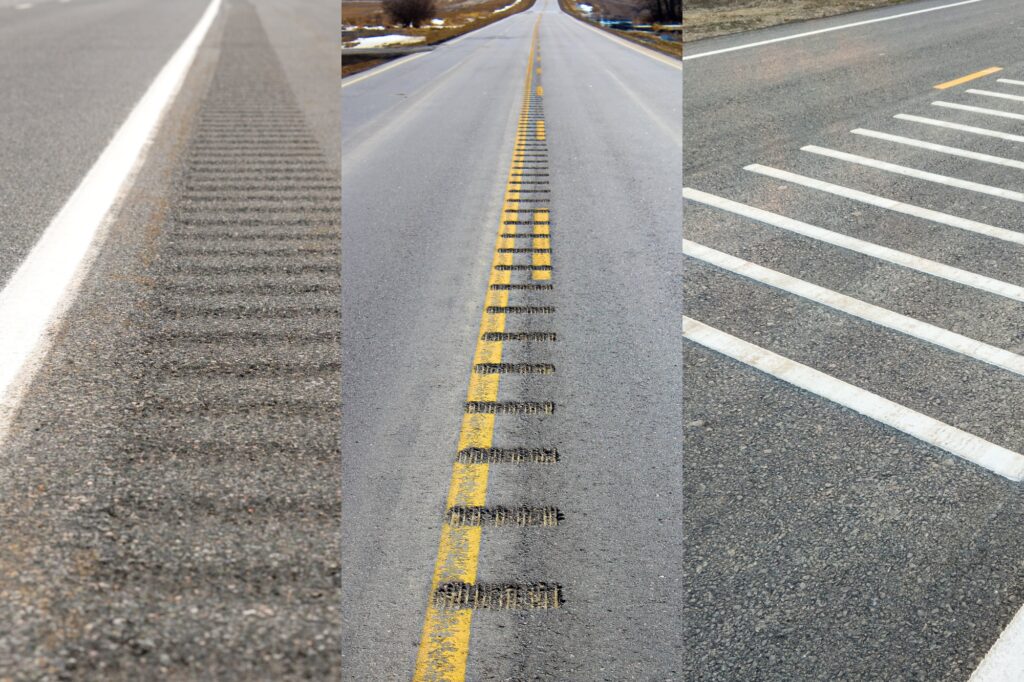Rumble strips are a safety feature on the road that alerts drivers of potential dangers ahead by causing a tactile vibration from the wheels through the vehicle interior. They are installed on pavements to alert distracted, drowsy, or inattentive drivers that they have left the travel lane.
They are designed to increase the likelihood of safe recovery after a roadway departure. These road markings are proven to reduce the number of run-off-road crashes and cross-center line crashes on undivided roads.
Types of Rumble Strips
There are three common types of rumble strips used as a countermeasure to reduce roadway crashes: center line, shoulder/edge line, and transverse rumble strips.

Center Line Rumble Strips
These strips are designed to reduce head-on collisions or opposite-direction sideswipe crashes by alerting drivers when they have strayed over the center line.
Shoulder and Edge Line Rumble Strips
Shoulder rumble strips are a countermeasure against run-off-the-road crashes, including rollover and fixed-object crashes. Edge line rumble strips are placed within shoulder rumble strips to improve the visibility of the marking on roads with narrow shoulders.
Transverse Rumble Strips
Transverse rumble strips are installed perpendicular to the travel lane to warn drivers to slow down because of upcoming intersections, toll plazas, horizontal curves, and road hazards such as work zones.
Common Rumble Strip Designs
Tactile pavement markings have been used to keep vehicles on the roadway for over fifty years. Two of the earliest designs were rolled-in rumble strips (for asphalt shoulders) and formed rumble strips (on concrete pavement).
By the 1990s, milled-in rumble strips became the preferred design by most transportation agencies in the US. They were installed on highways as well as two-lane roads because they can easily be installed on existing pavement, unlike the earlier designs.
Milled-in Rumble Strips
Milled rumble strips are a series of grooves installed on either asphalt or concrete pavement. Tires passing through these strips drop into the groove, producing noise and vibration to alert the driver.
These milled strips can be added to new or reconstructed road projects. Grooves can be added a little at a time, making it easy to install on existing roads.
Milled strips typically have a width of five to seven inches with 12-inch spacing and 0.5-inch depth. Their length may vary between 12 and 16 inches.
Raised Rumble Strips
Raised rumble strips use pavement markers to create line markings similar to milled ones. They’re usually two to 12 inches wide and are either round or rectangular. They are mostly used in countries with warmer climates where snow-plowing isn’t common. Their effectiveness has yet to be widely studied.

Formed Rumble Strips
Formed rumble strips share similar dimensions to milled strips. The only difference between the two is that formed strips are molded into freshly laid concrete pavements. Consistency and installation concerns limit the use of this design in paving operations.
Rolled-in Rumble Strips
Rolled-in rumble strips are formed by using a steel drum roller with protruding steel bars to roll the pavement while the asphalt is still hot. The biggest disadvantage of this method is that it is difficult to achieve consistent dimensions like those of milled strips. Insufficient compaction and difficulty installing gaps for bicycle users also make this design less practical.
Benefits of Rumble Strips
As mentioned, rumble strips are mainly a safety feature for drivers traversing unknown or potentially dangerous roads. Some of the main benefits of installing them are reduced crashes, improved visibility, attentive drivers, and reduced traffic speed.
Reduces Crashes
Edge line rumble strips reduce crashes by a little over 28%, while non-edge line strips reduce it by 8.9%. The percentage fluctuates for both on two-lane roads, as they reduce crashes by 39.2% and 41.9%.
Some studies also came to the conclusion that rumbles reduce crashes somewhere between 40% and 60%. Additionally, the same studies show that edge line rumble strips reduce fatal crashes by 29%.
Improves Road Visibility
Some of the strips are painted with a retroreflective coating to increase road visibility in low-visibility situations, such as poor weather or at night. These strips are referred to as rumble stripes.
Warns Drivers of Approaching Road Hazards
As mentioned, the main purpose of rumble strips is to alert and warn drivers of any potential dangers ahead. Some scenarios or locations where they’re usually placed include an approaching intersection, toll plazas, tricky curves, or work zones.
Encourages Drivers to Reduce Speed
Because of the tactile vibration and noise produced by rumble strips, drivers are prone to slow down after running over one. This greatly reduces the speed of the traffic on the highway, which reduces the risk of accidents.
Special Considerations in the Installation of Rumble Strips
While they are effective in reducing roadway crashes, the installation of rumble strips can increase noise in the area and negatively impact bicycle activity.
Noise Issues
Inside the car, you’re mostly feeling the effects of driving over rumble strips due to the vibration. However, the noise it produces is much more profound if you’re outside or near the vicinity. This causes noise pollution, especially in busy areas.
Accommodation for Cyclists
Cyclists typically take the shoulder to avoid fast-moving vehicles in the travel lane. Dimension adjustments may be done to provide additional usable space as well as reduce the impact of rumble strips on bicycles when they are traversed. Recurring short gaps also should be designed in shared roadways to allow bicyclists ease of movement from one side of the rumble to another.
Any information provided on this Website is for informational purposes only and is not intended to replace consultation with a professional mechanic. The accuracy and timeliness of the information may change from the time of publication.

















